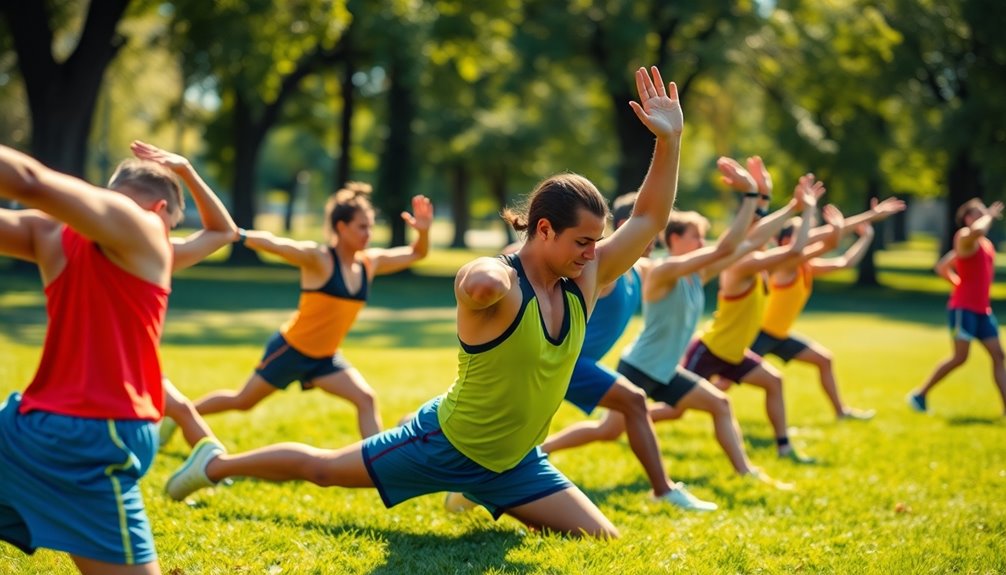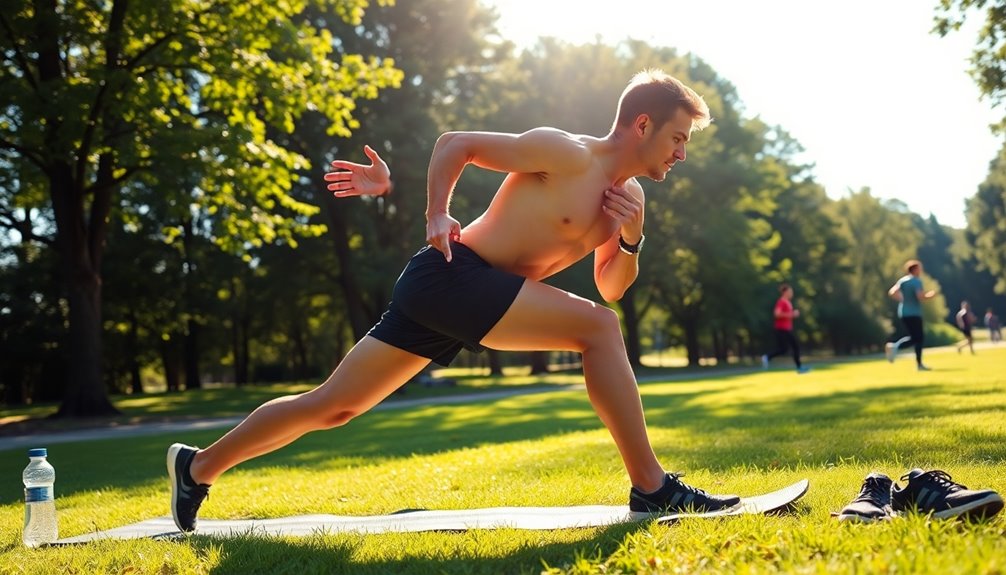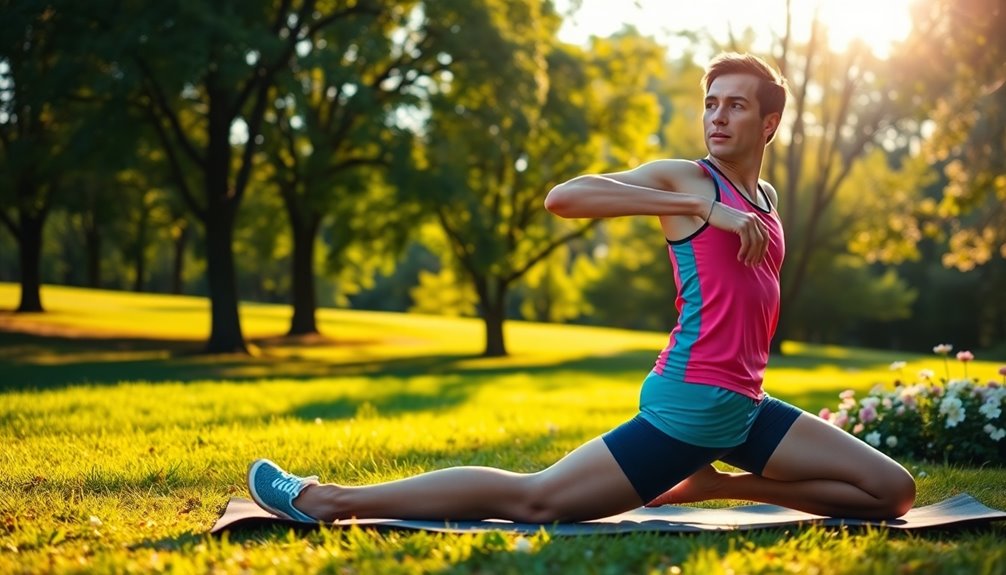To boost your running, incorporate essential stretching routines into your training. Start with dynamic stretches like high knees and butt kicks before you run to warm up your muscles and enhance performance. After your run, focus on static stretches for major muscle groups, holding each for 30-60 seconds to aid recovery and reduce soreness. Consistent stretching enhances flexibility, decreases injury risk, and supports your running goals. Discover more about effective techniques and practices to elevate your experience.
Key Takeaways
- Incorporate dynamic stretching before runs to enhance muscle activation and joint mobility for improved performance.
- Focus on key dynamic stretches like high knees, butt kicks, and leg swings to prepare muscles effectively.
- Engage in static stretching post-run to promote muscle recovery and flexibility, reducing soreness.
- Hold each static stretch for 30-60 seconds, targeting major muscle groups like hamstrings and quadriceps.
- Maintain a consistent stretching routine to improve flexibility and reduce the risk of injuries over time.
The Importance of Stretching for Runners

When you run, stretching isn't just an afterthought; it's an essential part of your routine. Incorporating stretching improves flexibility, enhancing your range of motion and running performance.
Dynamic stretching before your run warms up key muscle groups, while static stretching afterward helps maintain muscle elasticity. This combination considerably reduces the risk of injuries from tight muscles.
Regular stretching routines promote blood flow, aiding in quicker recovery time and less muscle soreness after your runs. By focusing on major muscle groups like the quadriceps, hamstrings, and calves, you guarantee balanced muscle development.
Ultimately, making stretching a priority not only supports injury prevention but also boosts your overall running efficiency, allowing you to enjoy your runs even more.
Dynamic Stretching: Preparing Your Muscles

Dynamic stretching is a crucial component of your pre-run routine, often taking just 5-10 minutes to elevate your heart rate and prepare your muscles.
This active form of stretching enhances muscle activation and joint mobility, making it essential for improving flexibility and performance. Unlike static stretches, dynamic movements, like high knees and butt kicks, warm up your muscles without lengthening them, reducing the risk of injury during your run.
Incorporating dynamic stretching into your warm-up routine helps promote better movement efficiency, allowing you to run more effectively.
Key Dynamic Stretches for Runners

To effectively prepare for your run, incorporating key dynamic stretches into your warm-up is essential. Spend 5-10 minutes engaging in movements like high knees, butt kicks, and leg swings. High knees elevate your hip flexors and core, while butt kicks activate your hamstrings, improving your running form. Don't forget leg swings to enhance flexibility and mobility in your hips. Additionally, performing these stretches can help reduce strain on joints, contributing to a more enjoyable running experience.
| Dynamic Stretch | Focused Muscles | Benefits |
|---|---|---|
| High Knees | Hip Flexors | Warm-up core |
| Butt Kicks | Hamstrings | Improve form |
| Leg Swings | Hip Flexors | Enhance mobility |
Adding skipping into the mix boosts coordination by engaging your calves and glutes. Incorporate these dynamic stretches for a more effective run!
Static Stretching: A Vital Post-Run Routine

After a run, static stretching is essential for your muscle recovery and helps reduce soreness by promoting blood flow.
Holding each stretch for 30 to 60 seconds can improve flexibility and prevent injuries, focusing on major muscle groups like your hamstrings and calves.
Let's look at some recommended static stretches that can boost your post-run routine.
Benefits of Static Stretching
While many runners focus on their pace and distance, the benefits of static stretching shouldn't be overlooked. Incorporating post-run stretches into your training routine can greatly enhance your flexibility and muscle elasticity. By holding each static stretch for 30 to 60 seconds, you effectively reduce muscle tension and aid in recovery, decreasing the risk of injury. Additionally, regular static stretching can contribute to a more optimized performance during your runs.
| Benefits of Static Stretching | Key Muscle Groups |
|---|---|
| Enhances flexibility | Hamstrings |
| Reduces muscle tension | Quadriceps |
| Aids in recovery | Calves |
| Decreases risk of injury | Hip flexors |
Targeting key muscle groups helps release lactic acid, promoting quicker recovery and preparing you for future runs. Don't skip this crucial practice!
Recommended Static Stretches
Incorporating recommended static stretches into your post-run routine can greatly enhance your recovery and flexibility. Focus on key static stretches like the hamstring stretch, calf stretch, and quadriceps stretch. Each of these targets major muscle groups engaged during your run.
Hold each stretch for 30-60 seconds to effectively reduce muscle tightness and promote muscle recovery. Avoid bouncing; instead, engage in smooth, controlled movements while breathing deeply. This approach helps increase flexibility and enhances recovery by improving blood flow to your muscles, aiding in the removal of lactic acid. Additionally, proper hydration is crucial to preventing fatigue after intense physical activity.
Essential Static Stretches for Recovery

Static stretching is an essential component of your post-run routine, as it helps relax your muscles and promotes recovery.
Incorporating key static stretches like the calf, hamstring, and quadriceps stretches targets major muscle groups engaged during running. Hold each stretch for 30-60 seconds to allow your muscles adequate time to lengthen, enhancing flexibility and further aiding recovery.
This practice not only helps reduce soreness and stiffness but also improves blood flow and reduces muscle tension. By consistently practicing these static stretches, you'll maintain and improve your range of motion, thereby reducing the risk of injury.
Make these stretches a non-negotiable part of your routine to enhance your overall running performance in future sessions.
Best Practices for Your Stretching Routine

To get the most out of your stretching routine, it's essential to understand the difference between dynamic and static stretches.
Timing matters too; warm up with dynamic stretches before your run and cool down with static stretches afterward.
Don't forget to target key muscle groups like your quadriceps, hamstrings, calves, and hip flexors for best recovery.
Dynamic vs. Static Stretching
Many runners overlook the importance of both dynamic and static stretching in their routines, but understanding their differences can greatly enhance your performance.
Dynamic stretching involves active movements that warm up your muscles and boost your heart rate, making it ideal for pre-run routines. Spend 5-10 minutes on dynamic stretches to prepare your body for the run ahead.
In contrast, static stretching involves holding positions for 15-60 seconds and is best performed post-run to aid in muscle recovery and improve flexibility.
Incorporating both types of stretching not only enhances flexibility and range of motion but also helps reduce injury risk.
Timing Your Stretches
Timing your stretches is essential for maximizing your running performance and recovery. Start with 5-10 minutes of dynamic stretching as a warm-up before your run to prepare your muscles and elevate your heart rate. After your run, switch to static stretching during your cool-down to relieve tight muscles and promote recovery. Remember to hold the stretch for 15-30 seconds to effectively enhance flexibility without discomfort. Incorporating both types of stretching into your routine not only improves performance but also aids in injury prevention. Regular stretching is key to maintaining and improving flexibility over time.
| Stretch Type | Timing | Duration |
|---|---|---|
| Dynamic Stretching | Pre-run | 5-10 minutes |
| Static Stretching | Post-run | 15-30 seconds each |
| Warm-up | Pre-run | Before stretching |
| Cool-down | Post-run | After running |
| Regular Stretching | Ongoing | Consistent routine |
Essential Muscle Groups
After you've warmed up and cooled down with the right stretches, it's important to focus on the muscle groups that play a key role in your running performance.
Target your quadriceps, hamstrings, calves, hip flexors, and glutes to enhance flexibility and prevent injuries.
Start your stretching routine with dynamic stretching, like leg swings and walking lunges, for about 5-10 minutes before running. This prepares your muscles for activity and boosts performance.
After your run, switch to static stretching, holding each stretch—such as the calf stretch and hamstring stretch—for 30-60 seconds. This aids in muscle recovery and reduces soreness. Additionally, incorporating proper planning into your routine can help you avoid injuries and enhance overall performance.
Enhancing Performance Through Flexibility

While you might focus on building endurance and speed, enhancing your performance through flexibility can be just as vital. Incorporating dynamic stretching before your runs can greatly improve flexibility by increasing muscle temperature and elasticity. This primes your muscles for ideal function, resulting in a greater range of motion and more powerful strides.
After your run, static stretches help maintain this improved flexibility, aiding in enhanced recovery by reducing muscle soreness and lactic acid buildup. Effective stretching routines also promote balance and stability, which are essential for maintaining proper running form and preventing injuries. Additionally, regular tick checks after outdoor runs can help prevent potential health issues related to tick bites.
Frequently Asked Questions
Can Stretching Help You Run Faster?
Yes, stretching can definitely help you run faster. By improving your flexibility and range of motion, stretching allows your muscles to work more efficiently.
When you incorporate dynamic stretches before your runs, you activate your muscles and increase blood flow, enhancing your performance.
Additionally, regular stretching reduces muscle tightness and soreness, promoting quicker recovery. This means you can train more often and maintain a higher speed, ultimately leading to better running times.
How Often Should I Stretch as a Runner?
You might think stretching takes too much time, but it's essential for your running. Aim to stretch at least 3-4 times a week.
Incorporate dynamic stretches before you run for about 5-10 minutes to warm up those muscles. After your run, switch to static stretches, holding each for 15-30 seconds.
This routine not only boosts your flexibility but also reduces the risk of injuries, keeping you on track with your running goals.
Do Elite Runners Stretch?
Yes, elite runners do stretch.
They often incorporate both dynamic stretching before workouts to activate muscles and improve mobility, and static stretching after exercise for recovery and flexibility.
This balanced approach helps them enhance performance and prevent injuries.
By regularly stretching, they maintain their flexibility, which is essential for peak running.
What Is the Classic Runner's Stretch?
Imagine you're preparing for a big race, and you want to guarantee your muscles are primed. The Classic Runner's Stretch is key.
You stand on one leg, pulling your heel toward your glutes, effectively stretching the front of your thigh. Maintain an upright posture and tuck your pelvis to deepen the stretch. Hold it for 30-60 seconds.
If you need support, use a wall. This stretch helps keep your quadriceps flexible and injury-free.
Conclusion
Just like a well-tuned instrument, your body needs the right stretches to create a beautiful symphony of movement while running. By weaving dynamic and static stretches into your routine, you're not just preventing injuries; you're crafting a masterpiece of flexibility and strength. Embrace each stretch as a brushstroke, painting your path to improved performance and joy in every stride. So, stretch your limits, and let your passion for running flourish like a vibrant garden in full bloom.









